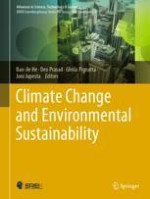2022 | OriginalPaper | Chapter
Environmental Kuznets Curve: A New Functional Form in the Case of Low-Income Countries
Authors : Yara Elsehaimy, Dina M. Yousri
Published in: Climate Change and Environmental Sustainability
Publisher: Springer International Publishing
Activate our intelligent search to find suitable subject content or patents.
Select sections of text to find matching patents with Artificial Intelligence. powered by
Select sections of text to find additional relevant content using AI-assisted search. powered by
